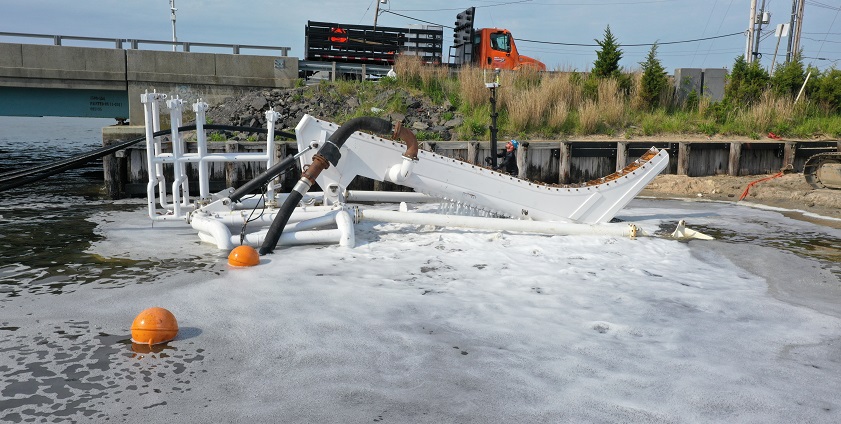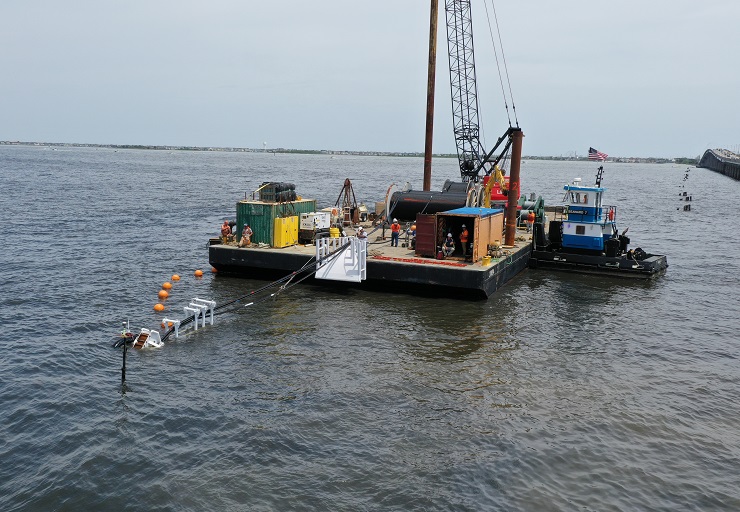Transmission Project Jets Its Way Across the Bay

In the shallow water by the mainland shore, the high-pressure water jets were tested before trench cutting began. As the 12-ton, 37-foot-long sled was pulled away from shore, a hydraulic mechanism pivoted the cutting blade down to blast through the soft, sandy bottom of the bay – safely depositing the conductor cables at the bottom of the 10-foot-deep trench as it went.
July 26, 2021
A Transmission Maintenance project replaced a 34.5-kilovolt transmission line that crosses more than a mile of Barnegat Bay to supply power to JCP&L customers on New Jersey’s coastal barrier islands – just in time for Memorial Day weekend, the traditional start of the Jersey Shore’s busy tourist season.
Making this job especially challenging – in addition to the tight completion deadline – was that it included burying the line under the bay’s silty, sandy bottom.
According to Edward “Pete” Copney, transmission program manager IV, the project was successful thanks largely to a well-coordinated team of FirstEnergy business units and contractors, including one with a special apparatus used for the first time on a FirstEnergy project: an underwater trench-cutting sled.
“The sled used water jets at 150 pounds-per-square-inch pressure to blast a trench about one foot wide and 10 feet deep in the soft bottom soil and lay the new power cables at the bottom of the trench as it went,” said Pete. “Then, as the sled was pulled along the bottom of the bay, the trench simply collapsed behind it. Only a long, shallow depression – a few inches deep – was left to show where the cable was buried.”
The sled was pulled across the bay behind a barge that carried massive reels of heavy, armored submarine cable, hydraulic pumps, water pumps, surveillance monitors, tracking instruments, control systems and other gear required for the sled’s operation. At rates of up to 10 feet per minute, a set of three power cables (one for each phase of the circuit) were laid and buried across 5,800 feet of the bay in only a few days. The route duplicated the path of the old cables – which were damaged, likely by a dredging operation, and had been removed – parallel to the State Route 37 bridge between Toms River on the mainland and Seaside Heights on the island.
Since the new cables run 10 feet below the bottom of the bay, they should be safely out of the way of future dredging. Each cable is wrapped with 28 strands of aluminum armor wire, so there was no need to bundle them together into a single armored casing, as is often used with underwater power lines. The deep burial also made obtaining the necessary environmental permits and other government clearances easier.
The new cables were connected at each end to above-ground termination equipment that also was replaced as part of the project. Just 31 days after work began, the new line was energized on May 28.
“The underwater jetting sled provided an efficient way to bury the cable, but the key to getting this project done correctly and on time was having everyone involved heading in the right direction together. And most important of all, we got the job done safely,” said Pete.
The project was completed ahead of the holiday weekend as planned. It turned out to be a good thing because the next day a car-pole accident affected another circuit supplying power to the islands. The line installed by this project helped minimize the impact of that incident.

With only the top framework and instrument mast of the sled showing, the barge and sled began moving into the deeper water of Barnegat Bay. While the bay is only 8-10 feet deep, the sled can operate in 130 feet of water or more and can be configured to cut a trench in the bottom as deep as 16 feet.